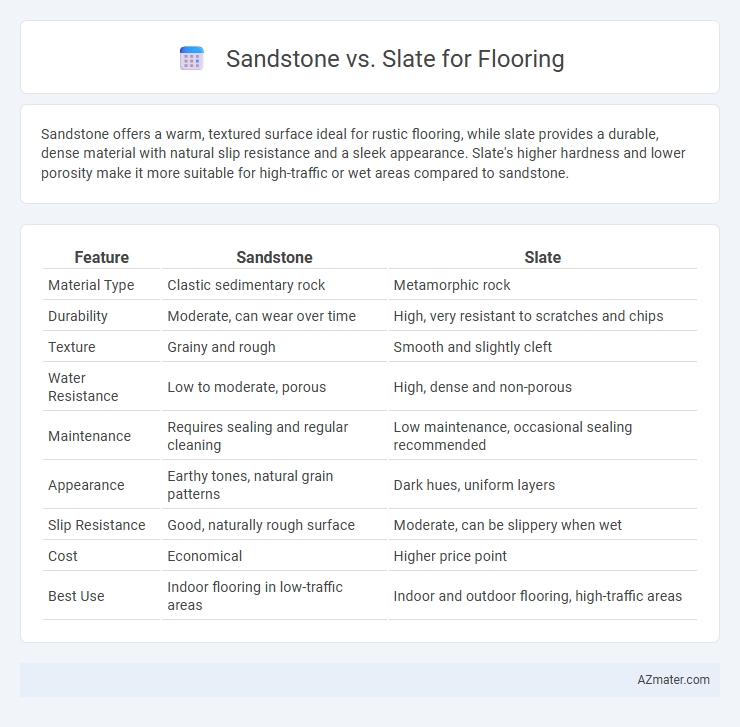Sandstone offers a warm, textured surface ideal for rustic flooring, while slate provides a durable, dense material with natural slip resistance and a sleek appearance. Slate's higher hardness and lower porosity make it more suitable for high-traffic or wet areas compared to sandstone.
Table of Comparison
| Feature | Sandstone | Slate |
|---|---|---|
| Material Type | Clastic sedimentary rock | Metamorphic rock |
| Durability | Moderate, can wear over time | High, very resistant to scratches and chips |
| Texture | Grainy and rough | Smooth and slightly cleft |
| Water Resistance | Low to moderate, porous | High, dense and non-porous |
| Maintenance | Requires sealing and regular cleaning | Low maintenance, occasional sealing recommended |
| Appearance | Earthy tones, natural grain patterns | Dark hues, uniform layers |
| Slip Resistance | Good, naturally rough surface | Moderate, can be slippery when wet |
| Cost | Economical | Higher price point |
| Best Use | Indoor flooring in low-traffic areas | Indoor and outdoor flooring, high-traffic areas |
Introduction to Sandstone and Slate Flooring
Sandstone flooring offers natural warmth and unique texture, with durability suitable for indoor and outdoor use, making it popular for rustic or Mediterranean design styles. Slate flooring provides exceptional strength and moisture resistance, featuring a sleek, layered appearance that adds elegance to kitchens, bathrooms, and entryways. Both materials are sedimentary stones but differ in composition, hardness, and maintenance requirements, influencing their suitability for various flooring applications.
Aesthetic Differences: Sandstone vs Slate
Sandstone flooring offers a warm, earthy palette with natural variations in beige, tan, and rust tones, creating a rustic and inviting ambiance. Slate flooring, characterized by its dense, fine-grained texture, presents a sleek, modern look with rich shades of gray, black, green, and occasionally purple, adding depth and sophistication to interiors. The distinct color patterns and surface finishes of sandstone and slate significantly influence the overall aesthetic appeal, making sandstone ideal for casual, organic settings and slate better suited for contemporary, elegant designs.
Durability and Longevity Comparison
Sandstone offers moderate durability with hardness levels ranging from 6 to 7 on the Mohs scale but is more porous, making it susceptible to wear and staining over time compared to slate. Slate, rated between 6 and 7.5 on the Mohs scale, is denser and less porous, providing superior resistance to chipping, cracking, and moisture damage, which contributes to its longer lifespan in flooring applications. For high-traffic areas requiring long-term performance, slate's enhanced durability and lower maintenance needs make it a preferred choice over sandstone.
Slip Resistance and Safety Features
Sandstone offers moderate slip resistance due to its natural textured surface, making it suitable for indoor and outdoor flooring where moisture may be present. Slate provides higher slip resistance with its denser, cleft texture, reducing the risk of slips especially in wet areas like bathrooms and kitchens. Both materials are durable, but slate's low porosity also contributes to its safety by minimizing water absorption and surface slipperiness.
Installation Process and Challenges
Sandstone flooring requires careful sealing and leveling during installation due to its porous nature and uneven texture, which can lead to moisture absorption and surface damage if not properly treated. Slate flooring demands precise cutting and fitting because of its natural cleft surface and tendency to split, requiring skilled labor to ensure a smooth, durable finish and prevent cracking. Both materials present challenges in grout selection to prevent staining, with sandstone needing more frequent maintenance to preserve its appearance compared to the more resilient slate.
Maintenance and Cleaning Requirements
Sandstone flooring requires regular sealing to prevent staining and moisture absorption, making routine cleaning with mild detergents essential to maintain its porous surface. Slate floors are more durable and less porous, needing less frequent sealing and better resistance to scratches and stains, which simplifies cleaning with pH-neutral cleaners. Both materials benefit from prompt spill cleanup, but sandstone demands more vigilant maintenance to preserve its natural texture and appearance.
Cost Analysis: Sandstone vs Slate
Sandstone flooring generally costs between $5 to $15 per square foot, making it a more budget-friendly option compared to slate, which ranges from $10 to $25 per square foot. Maintenance expenses are lower for sandstone due to its softer texture, but it may require more frequent sealing to prevent damage. Slate's higher initial cost is offset by its exceptional durability and resistance to wear, reducing long-term repair and replacement expenses.
Suitability for Indoor and Outdoor Spaces
Sandstone offers excellent durability and slip resistance, making it ideal for outdoor flooring in patios, walkways, and garden areas, while its warm tones complement indoor spaces like living rooms and kitchens. Slate provides a dense, non-porous surface with natural cleft texture suitable for both indoor flooring in high-traffic areas such as hallways and bathrooms, and outdoor use where moisture resistance is essential. Both materials require sealing to enhance longevity and maintain appearance, but sandstone's rough texture suits exterior environments better, whereas slate's refined finish is preferred indoors.
Environmental Impact and Sustainability
Sandstone flooring offers a low environmental impact due to its natural formation and minimal processing requirements, making it a sustainable choice with high durability and recyclability. Slate flooring has a longer lifespan and excellent resistance to moisture, reducing the need for replacement and lowering environmental waste, while its extraction process is more energy-intensive compared to sandstone. Both materials provide eco-friendly options when sourced locally and responsibly, contributing to reduced carbon footprint and sustainable building practices.
Which Flooring Is Best for Your Home?
Sandstone flooring offers a natural, warm aesthetic with excellent durability and slip resistance, making it ideal for high-traffic areas and outdoor spaces. Slate provides superior hardness, a rich color palette, and resistance to moisture, making it perfect for kitchens, bathrooms, and basements. Choosing between sandstone and slate depends on your home's style, foot traffic, and moisture exposure, with slate being better for wet areas and sandstone excelling in warmth and texture.

Infographic: Sandstone vs Slate for Flooring
 azmater.com
azmater.com